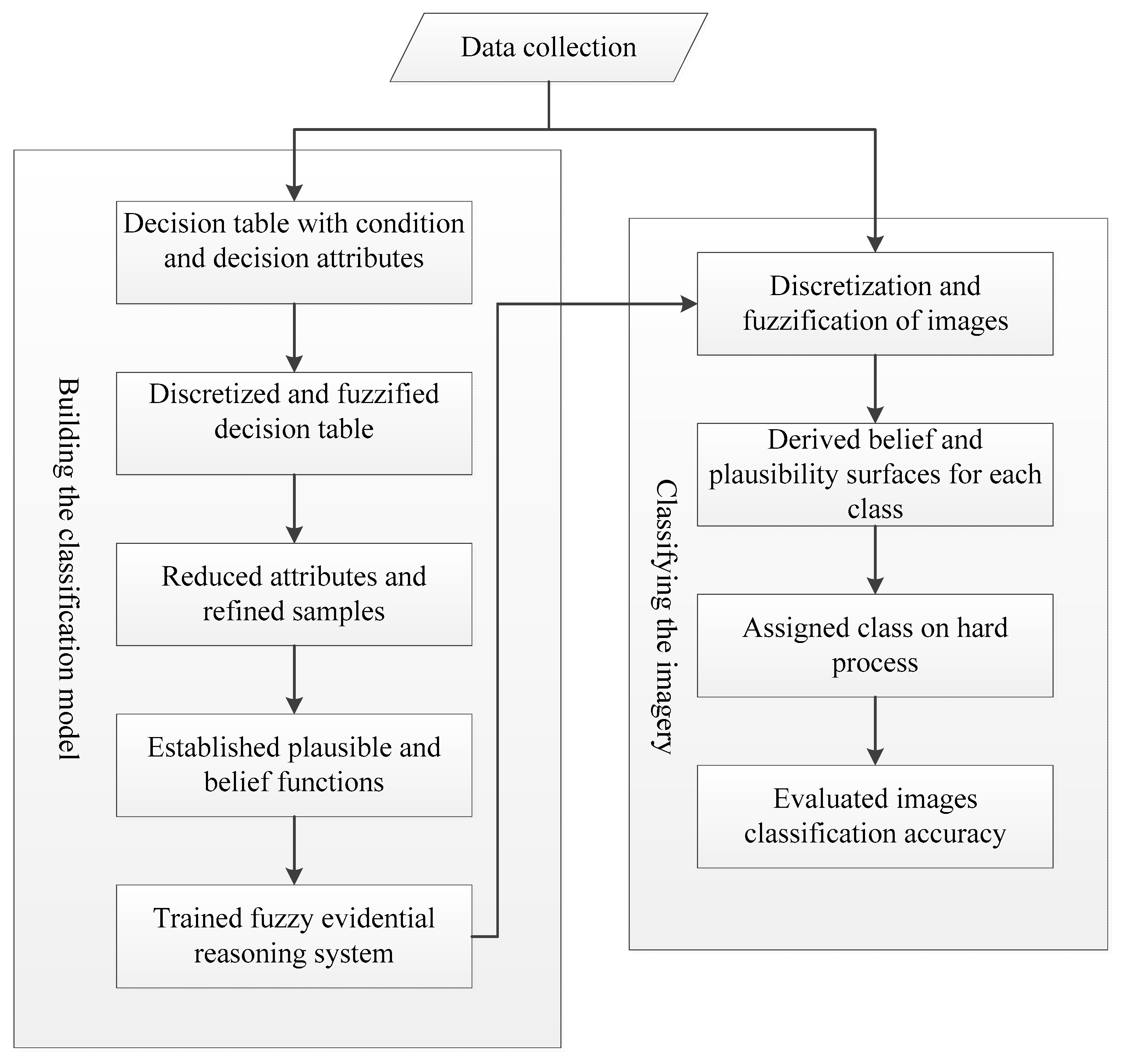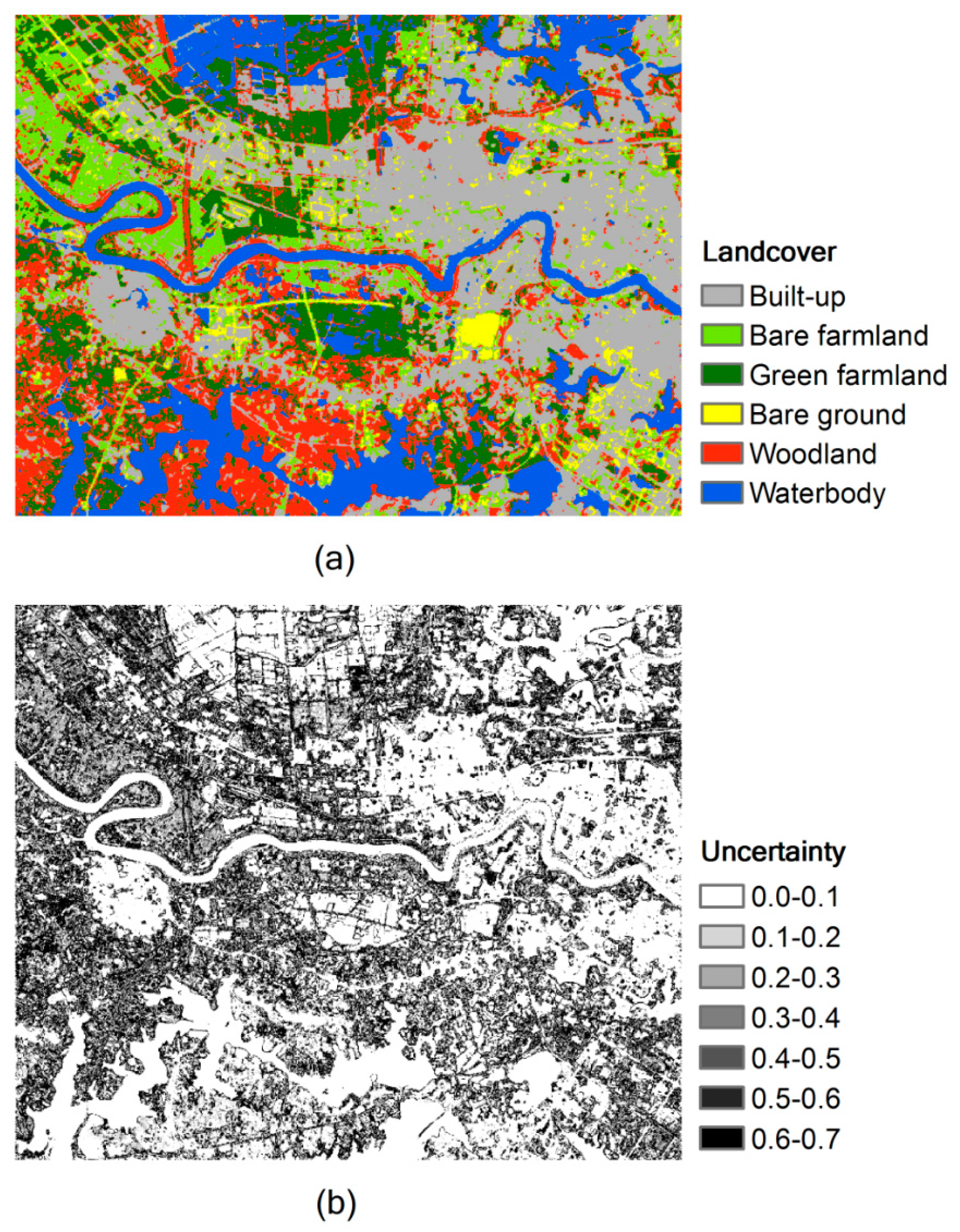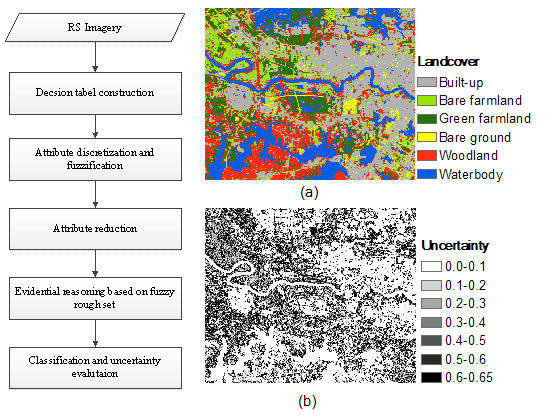Classification of Complex Urban Fringe Land Cover Using Evidential Reasoning Based on Fuzzy Rough Set: A Case Study of Wuhan City
Abstract
:1. Introduction
2. Preliminaries
2.1. Fuzzy Rough Set
2.2. Evidential Reasoning
2.3. Interpretation of Evidential Reasoning on Fuzzy Rough Set
3. Methodology
3.1. Study Area and Data Processing
3.2. Problem Formulation and Overview of Method
3.3. Decision Table Construction
3.4. Attribute Discretization and Fuzzification
3.5. Attribute Reduction
3.6. Evidential Reasoning Based on Fuzzy Rough Set
3.7. Accuracy Assessment and Comparison
4. Results and Discussion
4.1. Comparison of Classification Accuracy
4.2. Result Classification Using Fuzzy Rough Set and Evidential Reasoning (FRSER)
4.3. Comparison of Land Cover Estimations
4.4. Comparison of Overall Performance Characteristics
5. Discussion
6. Conclusions
Acknowledgments
Author Contributions
Conflicts of Interest
References
- Nemmour, H.; Chibani, Y. Multiple support vector machines for land cover change detection: An application for mapping urban extensions. ISPRS J. Photogramm. Remote Sens. 2006, 61, 125–133. [Google Scholar] [CrossRef]
- Weng, Q. Remote sensing of impervious surfaces in the urban areas: Requirements, methods, and trends. Remote Sens. Environ. 2012, 117, 34–49. [Google Scholar] [CrossRef]
- Zhang, R.; Zhu, D. Study of land cover classification based on knowledge rules using high-resolution remote sensing images. Expert Syst. Appl. 2011, 38, 3647–3652. [Google Scholar] [CrossRef]
- Guindon, B.; Zhang, Y.; Dillabaugh, C. Landsat urban mapping based on a combined spectral–spatial methodology. Remote Sens. Environ. 2004, 92, 218–232. [Google Scholar] [CrossRef]
- Liu, Y.; Zhang, B.; Wang, L.-M.; Wang, N. A self-trained semisupervised SVM approach to the remote sensing land cover classification. Comput. Geosci. 2013, 59, 98–107. [Google Scholar] [CrossRef]
- Yang, Y.; Zhou, Q.; Gong, J.; Wang, Y. An integrated spatio-temporal classification method for urban fringe change detection analysis. Int. J. Remote Sens. 2012, 33, 2516–2531. [Google Scholar] [CrossRef]
- Kavzoglu, T.; Colkesen, I. A kernel functions analysis for support vector machines for land cover classification. Int. J. Appl. Earth Obs. Geoinf. 2009, 11, 352–359. [Google Scholar] [CrossRef]
- Zhang, J.; Foody, G. A fuzzy classification of sub-urban land cover from remotely sensed imagery. Int. J. Remote Sens. 1998, 19, 2721–2738. [Google Scholar] [CrossRef]
- Mountrakis, G.; Im, J.; Ogole, C. Support vector machines in remote sensing: A review. ISPRS J. Photogramm. Remote Sens. 2011, 66, 247–259. [Google Scholar] [CrossRef]
- Friedl, M.A.; Brodley, C.E. Decision tree classification of land cover from remotely sensed data. Remote Sens. Environ. 1997, 61, 399–409. [Google Scholar] [CrossRef]
- Qiang, Y.; Lam, N.S. Modeling land use and land cover changes in a vulnerable coastal region using artificial neural networks and cellular automata. Environ. Monit. Assess. 2015, 187, 1–16. [Google Scholar] [CrossRef] [PubMed]
- Pawlak, Z. Rough sets. Int. J. Comput. Inf. Sci. 1982, 11, 341–356. [Google Scholar] [CrossRef]
- Pawlak, Z. Rough Sets: Theoretical Aspects of Reasoning about Data; Springer: Dordrecht, The Netherlands, 1991. [Google Scholar]
- Pawlak, Z. Rough classification. Int. J. Man-Mach. Stud. 1984, 20, 469–483. [Google Scholar] [CrossRef]
- Pawlak, Z. Some issues on rough sets. In Transactions on Rough Sets I; Springer: Berlin, Germany; Heidelberg, Germany, 2004; pp. 1–58. [Google Scholar]
- Pal, S.K.; Mitra, P. Multispectral image segmentation using the rough-set-initialized em algorithm. IEEE Trans. Geosci. Remote Sens. 2002, 40, 2495–2501. [Google Scholar] [CrossRef]
- Yun, O.; Ma, J. Land cover classification based on tolerant rough set. Int. J. Remote Sens. 2006, 27, 3041–3047. [Google Scholar] [CrossRef]
- Leung, Y.; Fung, T.; Mi, J.S.; Wu, W.Z. A rough set approach to the discovery of classification rules in spatial data. Int. J. Geogr. Inf. Sci. 2007, 21, 1033–1058. [Google Scholar] [CrossRef]
- Lei, T.; Wan, S.; Chou, T. The comparison of pca and discrete rough set for feature extraction of remote sensing image classification—A case study on rice classification, Taiwan. Comput. Geosci. 2008, 12, 1–14. [Google Scholar] [CrossRef]
- Pan, X.; Zhang, S.; Zhang, H.; Na, X.; Li, X. A variable precision rough set approach to the remote sensing land use/cover classification. Comput. Geosci. 2010, 36, 1466–1473. [Google Scholar] [CrossRef]
- Ge, Y.; Cao, F.; Duan, R. Impact of discretization methods on the rough set-based classification of remotely sensed images. Int. J. Digit. Earth 2011, 4, 330–346. [Google Scholar] [CrossRef]
- Xie, F.; Chen, D.; Meligrana, J.; Lin, Y.; Ren, W. Selecting key features for remote sensing classification by using decision-theoretic rough set model. Photogramm. Eng. Remote Sens. 2013, 79, 787–797. [Google Scholar] [CrossRef]
- Agrawal, A.; Kumar, N.; Radhakrishna, M. Multispectral image classification: A supervised neural computation approach based on rough–fuzzy membership function and weak fuzzy similarity relation. Int. J. Remote Sens. 2007, 28, 4597–4608. [Google Scholar] [CrossRef]
- Das, S.; Abraham, A.; Sarkar, S.K. A hybrid rough set—Particle swarm algorithm for image pixel classification. In Proceedings of the Sixth International Conference on Hybrid Intelligent Systems, Rio de Janeiro, Brazil, 13–15 December 2006; pp. 26–26.
- Liao, Y.; Wang, J.; Guo, Y.; Zheng, X. Risk assessment of human neural tube defects using a bayesian belief network. Stoch. Environ. Res. Risk Assess. 2010, 24, 93–100. [Google Scholar] [CrossRef]
- Wang, J.F.; Li, X.H.; Christakos, G.; Liao, Y.L.; Zhang, T.; Gu, X.; Zheng, X.Y. Geographical detectors-based health risk assessment and its application in the neural tube defects study of the Heshun region, China. Int. J. Geogr. Inf. Sci. 2010, 24, 107–127. [Google Scholar] [CrossRef]
- Du, Y.; Wen, W.; Cao, F.; Ji, M. A case-based reasoning approach for land use change prediction. Expert Syst. Appl. 2010, 37, 5745–5750. [Google Scholar] [CrossRef]
- Fischer, M.M.; Wang, J. Spatial Data Analysis: Models, Methods and Techniques; Springer-Verlag: Berlin, Germany; Heidelberg, Germany, 2011; p. 80. [Google Scholar]
- Cao, F.; Ge, Y.; Wang, J. Spatial data discretization methods for geocomputation. Int. J. Appl. Earth Obs. Geoinf. 2014, 26, 432–440. [Google Scholar] [CrossRef]
- Zhao, W.; Zhu, Y. Classifying email using variable precision rough set approach. In Rough Sets and Knowledge Technology; Springer: Berlin/Heidelberg, Germany, 2006; pp. 766–771. [Google Scholar]
- Pérez-Díaz, N.; Ruano-Ordás, D.; Méndez, J.R.; Gálvez, J.F.; Fdez-Riverola, F. Rough sets for spam filtering: Selecting appropriate decision rules for boundary e-mail classification. Appl. Soft Comput. 2012, 12, 3671–3682. [Google Scholar] [CrossRef]
- Rocchini, D.; Foody, G.M.; Nagendra, H.; Ricotta, C.; Anand, M.; He, K.S.; Amici, V.; Kleinschmit, B.; Förster, M.; Schmidtlein, S.; et al. Uncertainty in ecosystem mapping by remote sensing. Comput. Geosci. 2013, 50, 128–135. [Google Scholar] [CrossRef]
- Wu, W.-Z.; Mi, J.-S.; Zhang, W.-X. Generalized fuzzy rough sets. Inf. Sci. 2003, 151, 263–282. [Google Scholar] [CrossRef]
- Liu, B. Fuzzy rough theory. In Uncertainty Theory; Springer: Berlin, Germany; Heidelberg, Germany, 2004; pp. 349–367. [Google Scholar]
- Shafer, G. A Mathematical Theory of Evidence; Princeton University Press: Princeton, NJ, USA, 1976; p. 297. [Google Scholar]
- Dempster, A.P. Upper and lower probabilities induced by a multivalued mapping. Ann. Math. Stat. 1967, 38, 325–339. [Google Scholar] [CrossRef]
- Soh, L.-K.; Tsatsoulis, C.; Gineris, D.; Bertoia, C. Arktos: An intelligent system for SAR sea ice image classification. IEEE Trans. Geosci. Remote Sens. 2004, 42, 229–248. [Google Scholar] [CrossRef]
- Sun, W.; Liang, S.; Xu, G.; Fang, H.; Dickinson, R. Mapping plant functional types from MODIS data using multisource evidential reasoning. Remote Sens. Environ. 2008, 112, 1010–1024. [Google Scholar] [CrossRef]
- Cayuela, L.; Golicher, J.; Rey, J.S.; Benayas, J.R. Classification of a complex landscape using dempster–shafer theory of evidence. Int. J. Remote Sens. 2006, 27, 1951–1971. [Google Scholar] [CrossRef]
- Cao, G.; Hou, P.; Jin, Y.-Q.; Mao, X. Fusion of features in multi-temporal sar imagery to detect changes in urban areas. Int. J. Remote Sens. 2009, 30, 5989–6001. [Google Scholar] [CrossRef]
- Ran, Y.; Li, X.; Lu, L.; Li, Z. Large-scale land cover mapping with the integration of multi-source information based on the dempster–shafer theory. Int. J. Geogr. Inf. Sci. 2012, 26, 169–191. [Google Scholar] [CrossRef]
- Dubois, D.; Prade, H. Rough fuzzy sets and fuzzy rough sets. Int. J. Gen. Syst. 1990, 17, 191–209. [Google Scholar] [CrossRef]
- Denœux, T. Modeling vague beliefs using fuzzy-valued belief structures. Fuzzy Sets Syst. 2000, 116, 167–199. [Google Scholar] [CrossRef]
- Sikder, I.U.; Gangopadhyay, A. Managing uncertainty in location services using rough set and evidence theory. Expert Syst. Appl. 2007, 32, 386–396. [Google Scholar] [CrossRef]
- Bello, R.; Verdegay, J.L. Rough sets in the soft computing environment. Inf. Sci. 2012, 212, 1–14. [Google Scholar] [CrossRef]
- Yao, Y.; Lingras, P. Interpretations of belief functions in the theory of rough sets. Inf. Sci. 1998, 104, 81–106. [Google Scholar] [CrossRef]
- Kurgan, L.; Cios, K.J. Caim discretization algorithm. IEEE Trans. Knowl. Data Eng. 2004, 16, 145–153. [Google Scholar] [CrossRef]
- Kianmehr, K.; Alshalalfa, M.; Alhajj, R. Fuzzy clustering-based discretization for gene expression classification. Knowl. Inf. Syst. 2010, 24, 441–465. [Google Scholar] [CrossRef]
- Shen, Q.; Jensen, R. Rough sets, their extensions and applications. Int. J. Autom. Comput. 2007, 4, 217–228. [Google Scholar] [CrossRef]
- Smets, P. The degree of belief in a fuzzy event. Inf. Sci. 1981, 25, 1–19. [Google Scholar] [CrossRef]
- Hégarat-Mascle, L.; Bloch, I.; Vidal-Madjar, D. Application of dempster-shafer evidence theory to unsupervised classification in multisource remote sensing. IEEE Trans. Geosci. Remote Sens. 1997, 35, 1018–1031. [Google Scholar] [CrossRef]
- Barnett, J.A. Calculating dempster-shafer plausibility. IEEE Trans. Pattern Anal. Mach. Intell. 1991, 13, 599–602. [Google Scholar] [CrossRef] [Green Version]




| Class No. | Land Cover Type | Description | No. of Pixels | |
|---|---|---|---|---|
| Training Set | Test Set | |||
| 1 | Built-up | Buildings, roads and other impervious surface. | 254 | 239 |
| 2 | Bare farmland | Clear cut post-harvest farmland. | 62 | 47 |
| 3 | Green farmland | Farmland with growing crops. | 129 | 112 |
| 4 | Bare ground | Exposed land for future construction. | 80 | 67 |
| 5 | Woodland | Tree-covered land. | 165 | 121 |
| 6 | Waterbody | Fishponds, lakes and rivers. | 110 | 100 |
| Total | 1486 | |||
| Class 1 | 1 | 2 | 3 | 4 | 5 | 6 | User’s Accuracy (%) |
|---|---|---|---|---|---|---|---|
| FRSER: overall accuracy = 84.99%, kappa = 0.81 | |||||||
| 1 | 200 | 3 | 0 | 8 | 5 | 1 | 92.17 |
| 2 | 20 | 42 | 0 | 6 | 0 | 0 | 61.76 |
| 3 | 3 | 0 | 89 | 0 | 10 | 2 | 85.58 |
| 4 | 7 | 1 | 0 | 52 | 0 | 0 | 86.67 |
| 5 | 8 | 1 | 21 | 0 | 105 | 2 | 76.64 |
| 6 | 1 | 0 | 2 | 1 | 1 | 95 | 95.00 |
| Producer’s accuracy (%) | 83.68 | 89.36 | 79.46 | 77.61 | 86.78 | 95 | |
| MLC: overall accuracy = 72.89%, kappa = 0.67 | |||||||
| 1 | 145 | 7 | 0 | 7 | 3 | 1 | 88.96 |
| 2 | 38 | 37 | 0 | 9 | 2 | 0 | 43.02 |
| 3 | 2 | 0 | 71 | 0 | 11 | 2 | 82.56 |
| 4 | 37 | 2 | 0 | 50 | 0 | 0 | 56.18 |
| 5 | 15 | 1 | 39 | 0 | 103 | 3 | 63.98 |
| 6 | 2 | 0 | 2 | 1 | 2 | 94 | 93.07 |
| Producer’s accuracy (%) | 60.67 | 78.72 | 63.39 | 74.63 | 85.12 | 94 | |
| RS: overall accuracy = 77.11%, kappa = 0.70 | |||||||
| Unclassified | 0 | 0 | 1 | 0 | 0 | 0 | |
| 1 | 212 | 17 | 4 | 28 | 15 | 2 | 76.26 |
| 2 | 0 | 10 | 0 | 0 | 0 | 0 | 100.00 |
| 3 | 2 | 0 | 86 | 0 | 7 | 0 | 90.53 |
| 4 | 13 | 12 | 0 | 32 | 1 | 0 | 55.17 |
| 5 | 8 | 0 | 12 | 5 | 93 | 2 | 77.50 |
| 6 | 4 | 8 | 9 | 2 | 5 | 96 | 77.42 |
| Producer’s accuracy (%) | 88.70 | 21.28 | 76.79 | 47.76 | 76.86 | 96 | |
| FRS: overall accuracy = 79.59%, kappa = 0.76 | |||||||
| Unclassified | 3 | 0 | 4 | 2 | 6 | 0 | |
| 1 | 200 | 0 | 1 | 17 | 7 | 2 | 88.11 |
| 2 | 4 | 47 | 0 | 2 | 0 | 0 | 88.68 |
| 3 | 3 | 0 | 71 | 1 | 10 | 1 | 82.56 |
| 4 | 15 | 0 | 0 | 44 | 0 | 0 | 74.58 |
| 5 | 9 | 0 | 31 | 0 | 90 | 3 | 67.67 |
| 6 | 5 | 0 | 5 | 1 | 8 | 94 | 83.19 |
| Producer’s accuracy (%) | 83.68 | 100.00 | 63.39 | 65.67 | 74.38 | 94 | |
| VPFRS: overall accuracy = 83.09%, kappa = 0.80 | |||||||
| Unclassified | 3 | 0 | 1 | 1 | 1 | 1 | |
| 1 | 196 | 0 | 0 | 13 | 3 | 1 | 92.02 |
| 2 | 7 | 47 | 0 | 4 | 2 | 0 | 78.33 |
| 3 | 3 | 0 | 91 | 0 | 13 | 1 | 84.26 |
| 4 | 13 | 0 | 0 | 47 | 0 | 0 | 78.33 |
| 5 | 15 | 0 | 17 | 1 | 94 | 2 | 72.87 |
| 6 | 2 | 0 | 3 | 1 | 8 | 95 | 87.16 |
| Producer’s accuracy (%) | 82.01 | 100.00 | 81.25 | 70.15 | 77.69 | 95 | |
| Class 1 | MLC | RS | FRS | VPFRS | FRSEF | |||||
|---|---|---|---|---|---|---|---|---|---|---|
| Area (ha) | % | Area (ha) | % | Area (ha) | % | Area (ha) | % | Area (ha) | % | |
| 1 | 9883 | 23.9 | 15,662 | 37.8 | 15,380 | 37.2 | 13,866 | 33.5 | 13,913 | 33.6 |
| 2 | 5157 | 12.5 | 59 | 0.1 | 1587 | 3.8 | 2372 | 5.7 | 4627 | 11.2 |
| 3 | 5606 | 13.5 | 4824 | 11.7 | 5449 | 13.2 | 5504 | 13.3 | 6207 | 15.0 |
| 4 | 3872 | 9.4 | 4429 | 10.7 | 2364 | 5.7 | 1989 | 4.8 | 1343 | 3.2 |
| 5 | 9567 | 23.1 | 5931 | 14.3 | 8375 | 20.2 | 8359 | 20.2 | 8359 | 20.2 |
| 6 | 7308 | 17.7 | 9993 | 24.1 | 7155 | 17.3 | 7833 | 18.9 | 6944 | 16.8 |
| 7 | - | - | 495 | 1.2 | 1083 | 2.6 | 1470 | 3.6 | - | - |
| Classifier | Accuracy | Uncertainty Measure | Unclassified Pixels | Complexity | Extra Parameters |
|---|---|---|---|---|---|
| FRSER | High | Yes | No | High | No |
| MLC | Low | No | No | Low | No |
| RS | Medium | No | Yes | Low | No |
| FRS | Medium | No | Yes | Medium | No |
| VPFRS | High | No | Yes | High | Yes |
© 2016 by the authors; licensee MDPI, Basel, Switzerland. This article is an open access article distributed under the terms and conditions of the Creative Commons by Attribution (CC-BY) license (http://creativecommons.org/licenses/by/4.0/).
Share and Cite
Yang, Y.; Wang, Y.; Wu, K.; Yu, X. Classification of Complex Urban Fringe Land Cover Using Evidential Reasoning Based on Fuzzy Rough Set: A Case Study of Wuhan City. Remote Sens. 2016, 8, 304. https://doi.org/10.3390/rs8040304
Yang Y, Wang Y, Wu K, Yu X. Classification of Complex Urban Fringe Land Cover Using Evidential Reasoning Based on Fuzzy Rough Set: A Case Study of Wuhan City. Remote Sensing. 2016; 8(4):304. https://doi.org/10.3390/rs8040304
Chicago/Turabian StyleYang, Yetao, Yi Wang, Ke Wu, and Xin Yu. 2016. "Classification of Complex Urban Fringe Land Cover Using Evidential Reasoning Based on Fuzzy Rough Set: A Case Study of Wuhan City" Remote Sensing 8, no. 4: 304. https://doi.org/10.3390/rs8040304
APA StyleYang, Y., Wang, Y., Wu, K., & Yu, X. (2016). Classification of Complex Urban Fringe Land Cover Using Evidential Reasoning Based on Fuzzy Rough Set: A Case Study of Wuhan City. Remote Sensing, 8(4), 304. https://doi.org/10.3390/rs8040304









